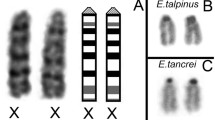Summary
-
1.
In common with many other mantids, Sphodromantis gastrica possesses a multiple sex chromosome mechanism of the X1X2Y ♂: X1X1X2X2♀-type. At meiosis in spermatocytes and at mitosis in embryo neuroblast cells it can be seen that S. gastrica differs from other species so far described in that the X2 element is acrocentric. Chiasma formation always takes place in the short arms of the chromosome.
-
2.
24 spontaneously autotetraploid cells at metaphase I were analysed with respect to the types and frequencies of multivalent associations, both for the sex chromosomes and for the autosomes. The chiasma frequencies in the autotetraploid cells were also recorded for comparison with those of diploid cells. The mean 4n cell total was found to be 26.7/cell, fully twice the 2n mean of 13.3/cell.
-
3.
In autotetraploid cells, two aberrant types of allosomal pairing associations suggest that the Y was, ancestrally, an isochromosome.
-
4.
It is suggested that, in addition to X-autosomal translocation, both polyploidy and centromeric misdivision have been involved in the evolution of the chromosome complement of S. gastrica and, perhaps, of all other X1X2Y mantids.
Similar content being viewed by others
References
Bauer, H.: Karyologische Notizen. I. Über generative Polyploidei bei Dermapteren. Z. Naturforsch. 2b, 63 (1947).
Bayreuther, K.: Die Oogenese der Tipuliden. Chromosoma (Berl.) 7, 508–557 (1956).
Bergerard, J., et J. Seugé: La Parthénogenèse accidentelle chez Locusta migratoria L. Bull. Biol. (Paris) 93, 16–37 (1959).
Callan, H. G.: Chiasma interference in diploid, tetraploid and interchange spermatocytes of the earwig, Forficula auricularia. J. Genet. 49, 209–213 (1949).
—, and P. Jacobs: The meiotic process in Mantis religiosa L. males. J. Genet. 55, 200–217 (1957).
Darlington, C. D.: Recent Advances in Cytology, 2nd Ed. Churchill: London 1937.
Goldschmidt, E.: Multiple sex chromosome mechanisms and polyploidy in animals. J. Genet. 51, 434–440 (1953).
Henderson, S. A.: Chromosome number and behaviour in the grasshopper Pholidoptera. Heredity 16, 181–186 (1961).
Hewitt, G. M.: A tetrasomic mosaic in the germ line of Chorthippus parallelus. Heredity 18, 505–512 (1963).
Hughes-Schrader, S.: Meiosis without chiasmata in diploid and tetraploid spermatocytes of the mantid Callimantis antillarum. Saussure. J. Morph. 73, 111–142 (1943a); - Polarisation, kinetochore movements and bivalent structure in the meiosis of male mantids. Biol. Bull. (Woods Hole) 85, 265–300 (1943b); - Expulsion of the sex chromosome from the spindle in spermatocytes of a mantid. Chromosoma (Berl.) 3, 257–270 (1948); - The chromosomes of mantids (Orthoptera: Manteidae) in relation to taxonomy. Chromosoma (Berl.) 4, 1–55 (1950); - The desoxyribonucleic acid content of the nucleus as a cytotaxonomic character in mantids (Orthoptera: Mantoidea). Biol. Bull. (Woods Hole) 100, 178–187 (1951); - The nuclear content of desoxyribonucleic acid and interspecific relationships in the mantid genus Liturgousa (Orthoptera: Mantoidea). Chromosoma (Berl.) 5, 544–554 (1953a); - Supplementary notes on the cyto-taxonomy of mantids (Orthoptera: Mantoidea). Chromosoma (Berl.) 6, 79–90 (1953b).
John, B., and S. A. Henderson: Asynapsis and polyploidy in Schistocerca paranensis. Chromosoma (Berl.) 13, 111–147 (1962).
—, and K. R. Lewis: Studies on Periplaneta americana. I. Experimental analysis of male meiosis. Heredity 11, 1–9 (1957); - Selection for interchange heterozygosity in an inbred culture of Blaberus discoidalis (Serville). Genetics 44, 251–267 (1959); - Chromosome structure in Periplaneta americana. Heredity 15, 47–54 (1960).
—, and B. Naylor: Anomalous chromosome behaviour in the germ line of Schistocerca gregaria. Heredity 16, 187–198 (1961).
Levan, A.: Meiosis of Allium porrum, a tetraploid species with chiasma localisation. Hereditas (Lund) 26, 454–462 (1940).
Lewis, K. R., and B. John: Studies on Periplaneta americana. II. Interchange heterozygosity in isolated populations. Heredity 11, 11–22 (1957); - Breakdown and restoration of chromosome stability following inbreeding in a locust. Chromosoma (Berl.) 10, 589–618 (1959).
Matthey, R.: La polyploidie animale naturelle. Proc. 9th Int. Congr. Genet. 1, 302–306 (1954).
McClintock, B.: The association of non-homologous parts of chromosomes in the mid-prophase of meiosis in Zea Mays. Z. Zellforsch. 19, 191–237 (1933).
Oguma, K.: The idiochromosomes of the mantis. J. Coll. Agri. Univ. (Hokkaido) 10, 1–27 (1921).
Sax, K.: The cytological mechanism of crossing over. J. Arnold Arb. (Harvard) 13, 180–212 (1932).
Sharma, G. P., R. Parshad, and P. Sehgal: Meiosis without chiasmata in Periplaneta americana. Nature (Lond.) 178, 1004–1005 (1956); - Cytological analysis of the male meiosis in Periplaneta americana. J. Genet. 56, 281–287 (1959).
Suomalainen, E.: Die Chromosomenverhältnisse in der Spermatogenese einiger Blattarien. Ann. Acad. Sci. fenn. A 4, 10, 1–60 (1946); - On polyploidy in animals. Proc. Finnish Acad. Sci. Lett. 1958, 1–15.
Wahrman, J.: Heredity 19 (Suppl.) in preparation (1964).
White, M. J. D.: Tetraploid spermatocytes in a locust, Schistocerca gregaria. Cytologia (Tokyo) 5, 135–139 (1933); - A new and anomalous type of meiosis in a mantid Callimantis antillarum Saussure. Proc. roy. Soc. B 125, 516–523 (1938); - The origin and evolution of multiple sex chromosome mechanisms. J. Genet. 40, 303–336 (1940); - The evolution of the sex chromosomes. I. The XO and X1X2Y mechanisms in praying mantids. J. Genet. 42, 143–172 (1941); - The chromosomes of the parthenogenetic mantid Brunneria borealis. Evolution (Kansas) 2, 90–93 (1948); - Animal Cytology and Evolution. Cambridge: Cambridge University Press 1954; - Telomeres and terminal chiasmata — a reinterpretation. Biol. Contribs. (Texas Univ.) 107–111 (1959); - A unique type of sex chromosome mechanism in an Australian mantid. Evolution (Lawrence, Kansas) 16, 75–85 (1962).
Author information
Authors and Affiliations
Additional information
Dedicated with respect to Professor Hans Bauer on the occasion of his sixtieth birthday.
Rights and permissions
About this article
Cite this article
Henderson, S.A. Chromosome behaviour in diploid and tetraploid cells of sphodromantis gastrica and its bearing on chromosome evolution in the mantids. Chromosoma 16, 192–221 (1965). https://doi.org/10.1007/BF00320949
Received:
Issue Date:
DOI: https://doi.org/10.1007/BF00320949




